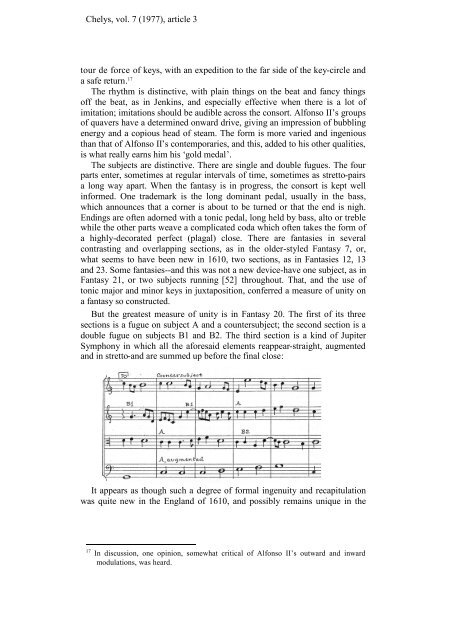download.pdf - 6.3Mb - Viola da Gamba Society
download.pdf - 6.3Mb - Viola da Gamba Society
download.pdf - 6.3Mb - Viola da Gamba Society
Create successful ePaper yourself
Turn your PDF publications into a flip-book with our unique Google optimized e-Paper software.
Chelys, vol. 7 (1977), article 3<br />
tour de force of keys, with an expedition to the far side of the key-circle and<br />
a safe return. 17<br />
The rhythm is distinctive, with plain things on the beat and fancy things<br />
off the beat, as in Jenkins, and especially effective when there is a lot of<br />
imitation; imitations should be audible across the consort. Alfonso II’s groups<br />
of quavers have a determined onward drive, giving an impression of bubbling<br />
energy and a copious head of steam. The form is more varied and ingenious<br />
than that of Alfonso II’s contemporaries, and this, added to his other qualities,<br />
is what really earns him his ‘gold me<strong>da</strong>l’.<br />
The subjects are distinctive. There are single and double fugues. The four<br />
parts enter, sometimes at regular intervals of time, sometimes as stretto-pairs<br />
a long way apart. When the fantasy is in progress, the consort is kept well<br />
informed. One trademark is the long dominant pe<strong>da</strong>l, usually in the bass,<br />
which announces that a corner is about to be turned or that the end is nigh.<br />
Endings are often adorned with a tonic pe<strong>da</strong>l, long held by bass, alto or treble<br />
while the other parts weave a complicated co<strong>da</strong> which often takes the form of<br />
a highly-decorated perfect (plagal) close. There are fantasies in several<br />
contrasting and overlapping sections, as in the older-styled Fantasy 7, or,<br />
what seems to have been new in 1610, two sections, as in Fantasies 12, 13<br />
and 23. Some fantasies--and this was not a new device-have one subject, as in<br />
Fantasy 21, or two subjects running [52] throughout. That, and the use of<br />
tonic major and minor keys in juxtaposition, conferred a measure of unity on<br />
a fantasy so constructed.<br />
But the greatest measure of unity is in Fantasy 20. The first of its three<br />
sections is a fugue on subject A and a countersubject; the second section is a<br />
double fugue on subjects B1 and B2. The third section is a kind of Jupiter<br />
Symphony in which all the aforesaid elements reappear-straight, augmented<br />
and in stretto-and are summed up before the final close:<br />
It appears as though such a degree of formal ingenuity and recapitulation<br />
was quite new in the England of 1610, and possibly remains unique in the<br />
17 In discussion, one opinion, somewhat critical of Alfonso II’s outward and inward<br />
modulations, was heard.
















